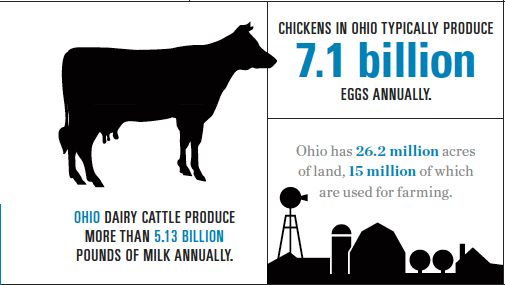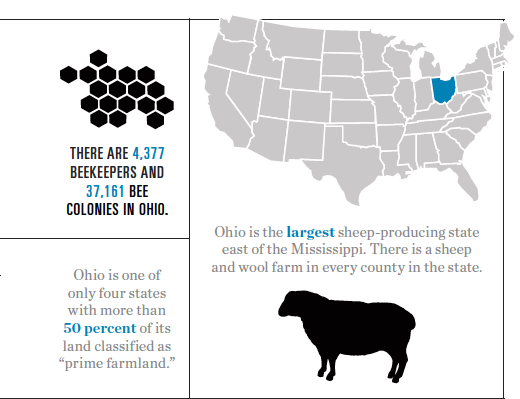Home > Ohio > Ohio Crops & Livestock > Ohio Agriculture Overview
Ohio Agriculture Overview
In partnership with: Ohio Department of Agriculture
Food and agriculture, the top industry in Ohio, adds $105 billion to the economy and employs one out of seven people in the state.
On-farm production alone contributes more than $6 billion annually. With jobs in horticulture, animal science, food science, forestry and more, there are more than 200 agriculturally related jobs. The Bureau of Labor and Statistics predicted this number would grow 18 percent between 2008 and 2018.
With 400 different types of soil, the Buckeye State is fully equipped to grow a wide variety of products. The rich soil typically receives 36 inches of rain each year and experiences a range of temperatures.
Ohio’s expansive tracts of land make it one of only four states with more than 50 percent of its land classified as “prime farmland.” Ohio ranks 11th in the nation for the number of farms, with 73,400, each averaging 184 acres.
Row crops such as soybeans and corn flourish in Ohio. As the No.1 crop, corn brought in $3.2 billion in 2011. Ohio soybeans, valued at $2.5 billion, are the No. 2 crop in the state.
Ohio excels in dairy production of all sorts. Particularly known for its Swiss cheese production, Ohio is ranked first in the country. Sour cream production follows behind, ranking No. 4 in the nation.
In addition to top-ranking crops, Ohio has many diverse commodities such as tomatoes, cucumbers and maple syrup. Ranking No. 5 nationally, Ohio has a long history of syrup production. In 2011, the trees of Ohio yielded an impressive 125,000 tons of syrup.
Food and beverages are a large part of the agricultural related economic impact. With 900 food processing plants, Ohio ranks in the top five U.S. producers of bakery, dairy, snacks, spices and other products. Ohio alone accounts for more than 4 percent of the national production of soft drinks, beer, wine and spirits.
Preserving the agricultural way of life is a priority in Ohio. Through farmland preservation programs, community supported agriculture groups and educational events, farmers receive information and support to enable them to continue growing quality products.





